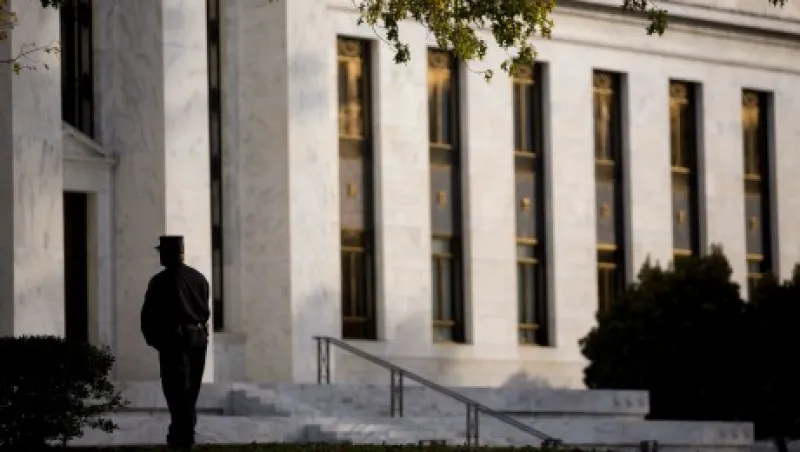Is it time to reduce global allocations to energy sector securities? In an interview yesterday with Institutional Investor Tom Stringfellow, president and chief investment officer of Frost Investment Advisors in San Antonio, indicated that while his firm had reduced overall exposure to the sector, it is keeping a foothold. “Looking out on a one-, two- or three-year time frame may not be the correct way to assess risk for the sector,” he says. According to Stringfellow, energy markets are focusing on the near-term potential for China to achieve its gross domestic product goals and forward-pricing levels in the futures markets, which are often privy to behavioral economics. “The oil market has proven itself time overtime of being capable of turning on a dime,” said Stringfellow. He added that “the recovery in the U.S. is gaining momentum and it is possible that commodities markets have discounted too much.”
FOMC meeting kicks off. The biggest macro event today is the start of the monthly Federal Open Market Committee meeting in Washington. While consensus forecasts call for no change, a growing number of analysts are anticipating a shift in language in tomorrow’s report to signal quantitative easing by the Federal Reserve, despite stubbornly low inflation.
Output rises in Japan. Japan’s Ministry of Trade reported industrial production data for September gained 2.7 percent for the month. Ironically, recent improvements in activity measures increase political pressures on Prime Minister Shinzo Abe’s administration as the potential impact of scheduled consumption tax hikes in 2015 is up for debate.
Visa reports quarterly earnings after the market close. Financial services company Visa is announcing quarterly earnings this afternoon. Among other risk factors, shareholders will focus on the company’s long-term plans to handle competition from new services such as Apple Pay, which was unveiled earlier this month.
Chinese insurance company reports rise in earnings. China Life Insurance, one of the nation’s largest insurers, reported a 22 percent increase in net income for the third quarter. Insurance is a sector that has provided a particularly bright spot in an overall bullish reporting season.
Norway’s sovereign wealth fund stumbles. In a quarterly report issued today, Norway’s Government Pension Fund Global, the world’s largest sovereign wealth fund, announced a gain of only 0.1 percent for the third quarter, the lowest return for the fund in more than a year. A slump in euro-denominated assets and geopolitical uncertainty were identified by analysts as drivers for the poor returns.
Portfolio Perspective: Illiquidity and Contamination Lead to Fast Spikes in Volatility — Ignacio Pakciarz, Big Sur Partners
There’s a huge stockpile of liquidity in the world, created by the unorthodox global accommodative monetary policies. But we are seeing illiquidity in the markets. How is this possible? We need to understand the difference between stock and flow. There’s clearly an abundance of money in the system; that is, of liquidity, as corporations and households are sitting on unprecedented levels of cash. What is more relevant, however, is the flow, or the degree to which assets can be traded. For cash to translate into liquidity, the mechanisms for cash to flow through to the markets must be free flowing. Thanks to structural risks created as a consequence of monetary policy, these pipelines have become narrow and bottlenecked, creating illiquidity and large gaps down — or up — in prices.
The heavy amount of cash on the sidelines should provide some protection on the downside, as some of it should be put to work. It’s important for investors to understand, however, that there is a lot of cash in the system it is not necessarily a bull signal to the markets. Illiquidity and contamination will create fast spurts of volatility that can translate into tradable situations, as we saw last week. The nervousness in the markets, relating to the fundamental unknowns and also the herd risk off behavior relating to noise such as Ebola or other geopolitical risks, may also contribute to heightened volatility.
There will be fast spurts of volatility even in large and mature markets like U.S. equities and U.S. Treasuries. But these will likely revert quickly and rally back. We can see these times as opportunities to trade, as was the case October 15 when the market tumbled 250 points within a span of 15 or 20 minutes. In the end, contamination cleared and as the forced sellers were cleaned up from the market, things normalized.
In niche or risky asset classes, there is risk associated with illiquidity and contamination. For these types of markets, we will be careful to analyze the liquidity, bid-ask spread of securities we would potentially buy or sell for our clients. It’s very important for investors to understand the liquidity dynamics for the specific security, asset type and asset class. Prices may gap down very quickly in these markets, because everyone is on the same side of the trade, there is limited inventory, and bid-offer spreads widen tremendously.
Ignacio Pakciarz is a founding partner and CEO of BigSur Partners, a global multifamily office based in Miami.






